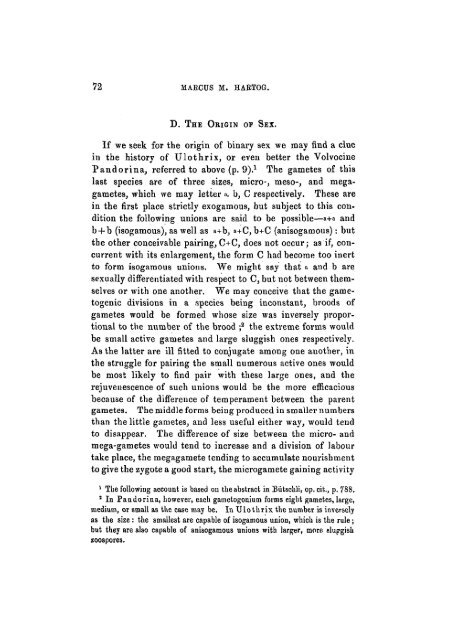Some Problems of Reproduction: a Comparative Study of ...
Some Problems of Reproduction: a Comparative Study of ...
Some Problems of Reproduction: a Comparative Study of ...
Create successful ePaper yourself
Turn your PDF publications into a flip-book with our unique Google optimized e-Paper software.
72 MARCUS M. HABTOG.<br />
D. THE ORIGIN OF SEX.<br />
If we seek for the origin <strong>of</strong> binary sex we may find a clue<br />
in the history <strong>of</strong> Ulothrix, or even better the Volvocine<br />
Pandorina, referred to above (p. 9). 1 The gametes <strong>of</strong> this<br />
last species are <strong>of</strong> three sizes, micro-, meso-, and megagametes,<br />
which we may letter », b, C respectively. These are<br />
in the first place strictly exogamous, but subject to this condition<br />
the following unions are said to be possible—a+a and<br />
b + b (isogamous), as well as a+b, a+C, b+C (anisogamous): but<br />
the other conceivable pairing,C+C, does not occur; as if, concurrent<br />
with its enlargement, the form C had become too inert<br />
to form isogamous unions. We might say that a and b are<br />
sexually differentiated with respect to C, but not between themselves<br />
or with one another. We may conceive that the gametogenic<br />
divisions in a species being inconstant, broods <strong>of</strong><br />
gametes would be formed whose size was inversely proportional<br />
to the number <strong>of</strong> the brood ; 2 the extreme forms would<br />
be small active gametes and large sluggish ones respectively.<br />
As the latter are ill fitted to conjugate among one another, in<br />
the struggle for pairing the small numerous active ones would<br />
be most likely to find pair with these large ones, and the<br />
rejuvenescence <strong>of</strong> such unions would be the more efficacious<br />
because <strong>of</strong> the difference <strong>of</strong> temperament between the parent<br />
gametes. The middle forms being produced in smaller numbers<br />
than the little gametes, and less useful either way, would tend<br />
to disappear. The difference <strong>of</strong> size between the micro- and<br />
mega-gametes would tend to increase and a division <strong>of</strong> labour<br />
take place, the megagamete tending to accumulate nourishment<br />
to give the zygote a good start, the microgamete gaining activity<br />
1 The following account is based on the abstract in Butschli, op. cit., p. 788.<br />
1 In Pandorina, however, each gametogoniutn forms eight gametes, large,<br />
medium, or small as the case may be. In Ulotlirix the number is inversely<br />
as the size : the smallest are capable <strong>of</strong> isogamous union, which is the rule;<br />
but they are also capable <strong>of</strong> anisogamous unions with larger, more sluggish<br />
zoospores.

















